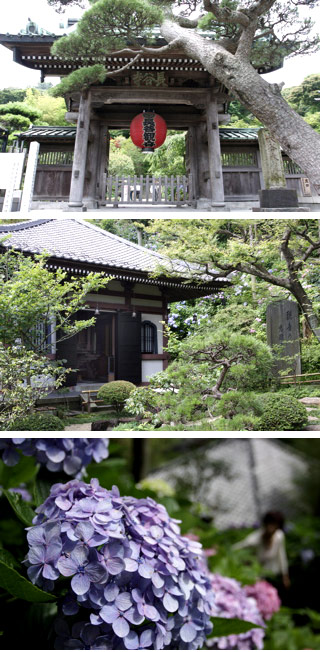According to legend, in 721 AD the pious monk Tokudo Shonin discovered a large camphor tree in the mountain forests near the village of Hase in the Nara region. He realized the trunk of the tree was so large that it provided enough material for carving two statues of the eleven-headed Kannon. The statue he commissioned to be carved from the lower part of the truck was enshrined in Hasedera Temple near Nara; the statue from the upper half (actually the larger of the two) was thrown into the sea with a prayer that it would reappear to save the people. Fifteen years later in 736 on the night of June 18, it washed ashore at Nagai Beach on the Miura Peninsula not far from Kamakura, sending out rays of light as it did. The statue was then brought to Kamakura and a temple was constructed to honor it. Since time immemorial, Hasedera Temple has been known as the 4th station among the 33 holy places in the Kanto area.
Kannon-do Hall
The magnificent statue of Hase Kannon is housed here for all to see and worship. It is 9.18 meters (30.1 ft.) tall and has eleven heads in addition to its main one: three in front, three to the left and three to the right, plus one at the top and another on back. Each face has a different expression, signifying that the deity listens to the wishes of all types of people. Hase Kannon is unique in that it holds a staff made of tin in its right hand and a vase of lotus flowers in its left. Gold leaf was applied to the statue in 1342 at the request of Ashikaga Takauji, and in 1392, Ashikaga Yoshimitsu had the halo added. Although Kannon is usually described in English as “the Buddhist Goddess of Mercy,” strictly speaking it is neither masculine nor feminine. Kannon is Avalokitesvara Bodhisattva--a Bodhisattva is a future Buddha, destined for enlightenment, who has vowed to save all sentient beings--and represents compassion, mercy, and love.
Amida-do Hall
Next to Kannon-do is a building where a golden seated statue of Yakuyoke (Protector from Evil Spirits) Amida Buddha, one of Kamakura’s six principal statues of Amida, is enshrined. It was commissioned by Minamotono Yoritomo, the first shogun of Japan, in 1194 and measures 2.8 meters (9.2 ft.) in height.
Daikoku-do Hall
Across the small Japanese garden from Kyozo is housed an image of Daikokuten. It is a replica of the original one in the Homotsu-kan Museum, which was carved in 1412, making it the oldest image of its type in Kanagawa prefecture. Daikokuten is one of the Seven Japanese Gods of Fortune. He is considered the god of wealth (or more specifically, the harvest), or of the household, particularly the kitchen. Recognized by his wide face and beaming smile, he is often portrayed holding a golden mallet and standing or sitting on bales of rice.
Benten-do Hall and Benten-kutsu Cave
On the lower level on the other side of Hojo-ike pond is Benten-do Hall. Inside is a small statue of Benzaiten with eight arms. According to legend, Kobo Daishi carved it himself while in seclusion, inspired by Buddha. On the other side of the hall is Benten-kutsu Cave where Benzaiten and 16 children are chiseled out of the rock walls. Benzaiten is a sea goddess and the only female among the Seven Lucky Gods of Japan. Her temples and shrines are located near water--the sea, a river, or a pond. She is the patron of music, the fine arts, and good fortune in general, and usually carries a biwa (Japanese mandolin) or plays a lute. Be careful inside the cave. It is dark and the ceiling is low, so watch your step.
(reference: Hasedera Official site)
Hasedera Official site: http://www.hasedera.jp






